Average sizes and life expectancy for this breed:
The Shar Pei is believed to be one of the most ancient dog breeds. They were originally bred to guard, herd, and hunt in their native country, China. This dog breed is one of the most recognised in the world because of the wrinkles around their faces and their blue or black tongues. The latter is an unusual trait that is only shared with one other dog breed, the Chow Chow. Another distinguishing feature of the Shar Pei is their coat, which is bristly to touch even though it looks soft.
The Shar Pei name means ‘sand skin’. referring to their distinct, bristle-like coat. But that's not the only thing uncommon about the Chinese Shar-Pei's coat. They are a solid mass of loose wrinkles and folds of skin that make them look like they are wearing a large, oversized suit.
Aside from their unique appearance, the Shar Pei has many personality traits that make them perfect for family living. They are loyal, calm, intelligent, and protective. They are also independent thinkers, that are known to be reserved around strangers – a trait that stems from their history as guard dogs and fighting dogs. This makes them excellent watchdogs; however, consistent training is necessary to ensure they understand their role in the family.
The Shar Pei we see today is less wrinkled and taller than the original dogs that first came out of China. In fact, back in the 1970s, this amazing dog breed was once considered to be one of the rarest breeds in the world. But, through the efforts of devoted breeders, the Shar Pei has steadily gained in popularity once again.
See available puppies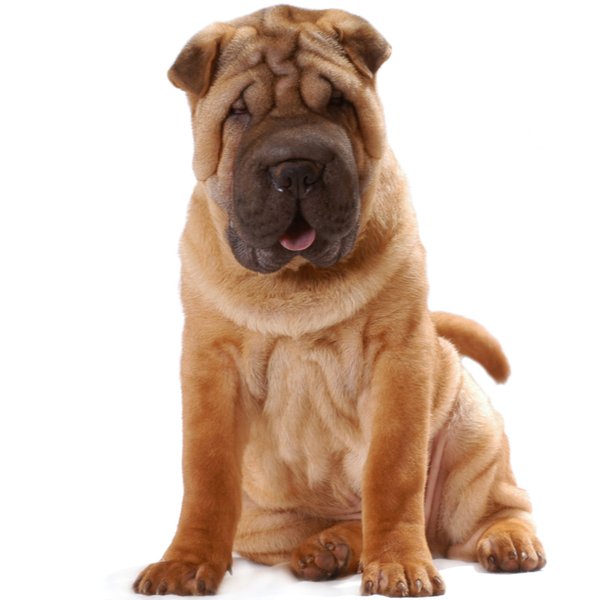

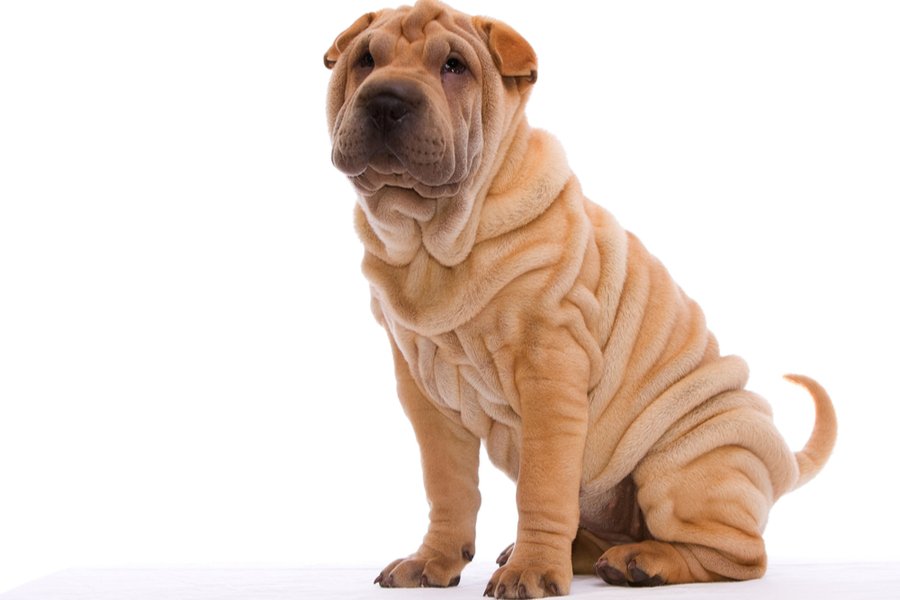


The Shar Pei, also called the Chinese Fighting Dog, is an ancient dog breed that is thought to date back to 200 BC in the Guangdong province of China. Images of similar-looking dogs have been found on pottery pieces from the Han Dynasty (206 BC). Their exact origin is uncertain, but they could be related to the Chow Chow because both breeds have distinct blue-black tongues. The Shar Pei is actually classified as one of the Basal breeds that predate the origins of modern dog breeds in the 19th century.
For many years, this breed was kept as a working farm dog; hunting, herding, and guarding livestock. The original Shar Pei looked very different from the breed we know now. In fact, even today, people from Southern China, Macau, and Hong Kong call the Western-type and Eastern-type Shar Pei by different names; Meat-Mouth and Bone-Mouth respectively.
Later on, these canines were used as fighting dogs. Their wrinkly coats were originally used to help the Shar Pei fend off wild boar. However, they also had another advantage during fights. The Shar Pei has the impressive ability to turn around 360 degrees and bite their attacker, even if they are being held.
Unfortunately, war and political turmoil caused the population of Shar Pei in China to drop dramatically during the Communist Revolution. The number of these dogs was further affected by the introduction of extortionate taxes for anyone who owned a dog in China in the 1940s.
During the last century, China’s border was opened. Fiercer and stronger breeds were introduced, such as Mastiffs and Bulldogs. They were mated with local dogs, which made the Shar Pei even less popular as a fighting breed. By the late 1960s, this breed was named in the Guinness Book of Records as the rarest dog breed in the world.
In 1973, it was Matgo Law, a Chinese businessman that begged America to try to revive the breed by promoting it in a local dog magazine. Over the following years, around 200 of these dogs were smuggled into America. Every Shar Pei in America today can trace their lineage back to these original dogs.
The first Shar Pei dogs that were taken out of China had shorter legs and many more folds and wrinkles. As a result, a lot of them suffered from a condition called entropion; a painful eye condition. But, through meticulous and selective breeding, this condition has been improved in the Shar Pei. Breeders started producing dogs with longer legs, fewer folds in their skin, and much healthier eyelids.
Luckily, the dog breed quickly caught the attention of the dog world, and many American breeders were eager to save the Shar Pei from extinction.
The first Shar Pei arrived in England in 1981. These were closely followed by another batch directly from Matgo Law.
About 350 dogs were registered with the Kennel Club after four years as their numbers rose steadily. Over the following years, these wonderful dogs were exported to different countries such as Australia, Cyprus, Italy, New Zealand, Russia, and South Africa. In 1999, the Kennel Club granted the Shar Pei breed Championship Status.
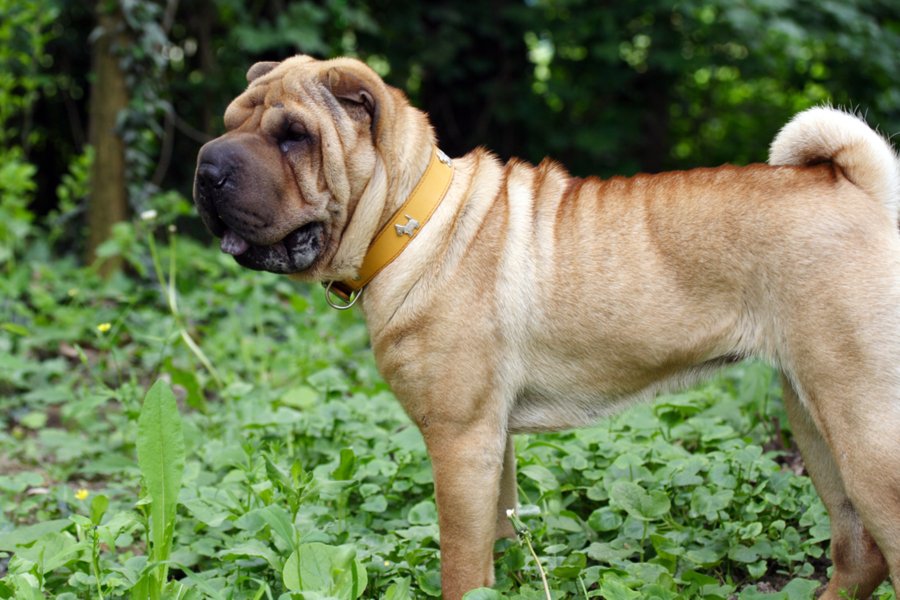
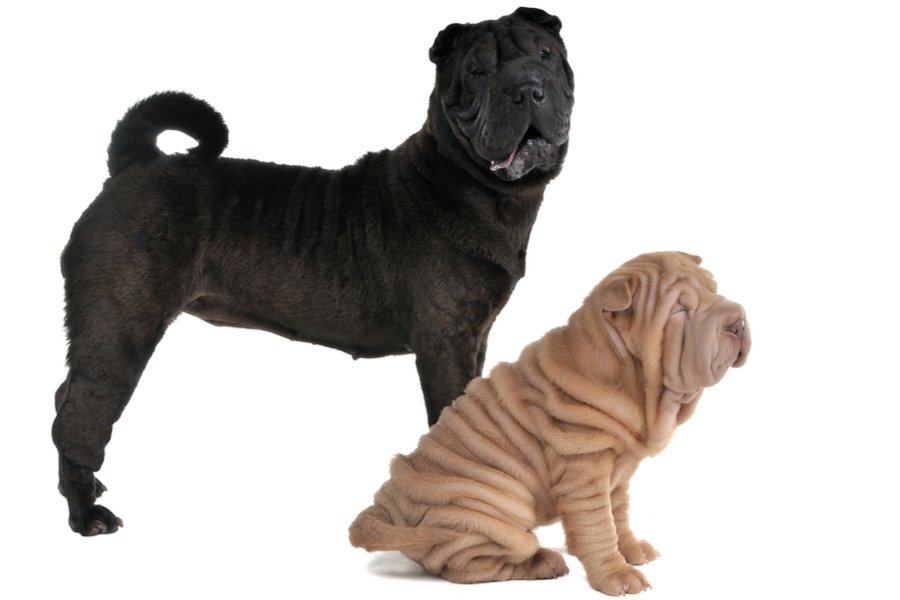
The Shar Pei is one of the most recognisable dog breeds because of the loose skin folds all over the face and body. They have relatively compact and square bodies with large, broad skulls and a moderate stop. These dogs always have a fair number of wrinkles on their cheeks and foreheads.
They have semi-broad, slightly padded muzzles, and lips. They also have wide, large noses that should ideally be black in colour. Shar Pei have almond-shaped, medium-sized eyes that are dark in colour too. Their small, thick ears are set high on the head. These are triangular-shaped with somewhat rounded tips and fold downwards towards the eyes.
Their moderately long necks are full and strong. Their muscular shoulders are laid back and sloping. Shar Pei have straight front legs and very muscular back legs that should not be excessively wrinkled. These dogs have narrow tails with the base set very high. They are often carried curled over the back.
When it comes to their short coats, Shar Pei have a harsh, straight coating of fur that stands away from the body. Their impressive coats may look soft, but it is actually short and coarse to the touch. This dog breed does not have an undercoat, and the length of the hair can vary between 1.25-2.5 cm. All solid colours are acceptable except for white. The Shar Pei coat can also be lighter on the tail and the back of the thighs.
Shar Pei dogs are very loyal, devoted, and loving by nature. They are also highly protective of their families so they are not the best choice for first-time dog owners. Shar Pei have an independent streak and are very wary around strangers so they need owners that understand their unique needs.
Once they form a bond with their owners or families, these dogs become valued members of the household. Shar Pei are not overly active and often love lazing inside the home. They require around 40-50 minutes of exercise per day to remain happy. These dogs are also not considered to be big barkers. Instead, they have an aloof, calming, charm that has seen them become increasingly popular in recent years.
A Shar Pei puppy needs to be properly socialised and trained from an early age. They need to be taught who the alpha is to ensure they become obedient and loving canines.
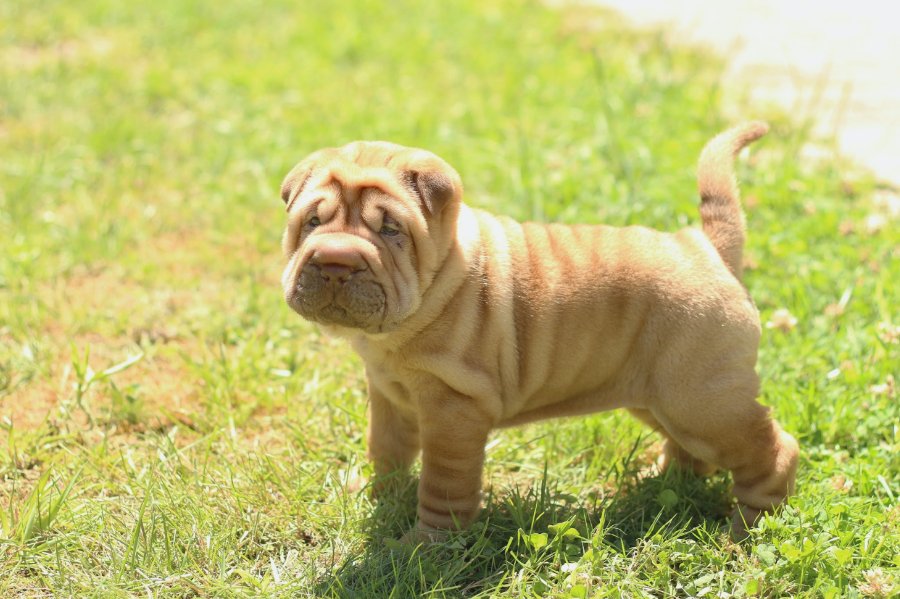
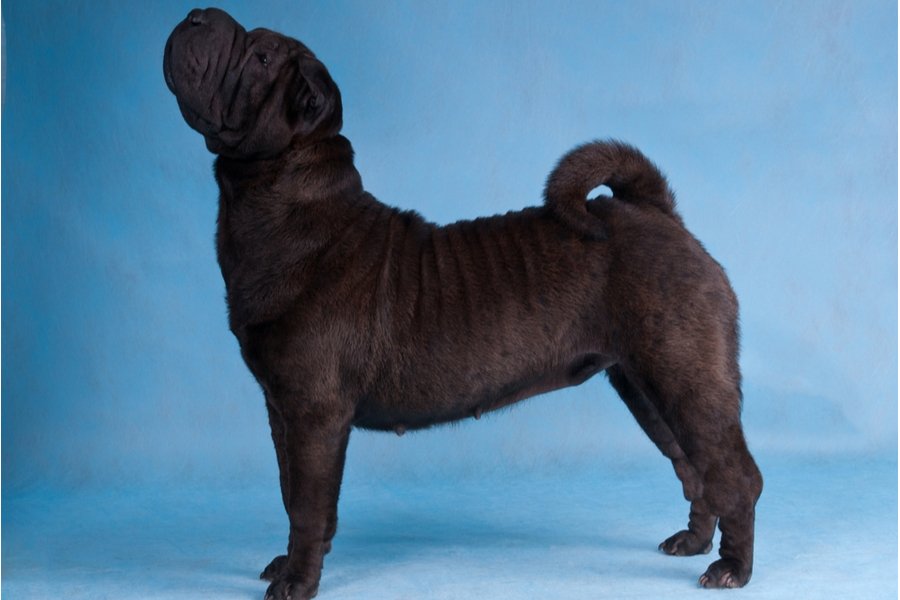
The Shar Pei is smart and willing. However, they can be stubborn which can make them a little difficult to train at times. Saying that, they are known to be one of the easiest dogs to housetrain as long as you are consistent.
Early socialisation and puppy training classes are highly recommended for this breed. You should also ensure you regularly introduce new people, dogs, sights, and sounds on a regular basis as they grow.
Shar Pei respond well to firm positive reinforcement training. Keep training sessions exciting and engaging with plenty of treats and fuss. Shar Pei can get bored easily so it might be best to keep training sessions short in the beginning. Consistency and patience are key!
The Chinese Shar Pei needs only minimal grooming. Once a week or so is ideal. However, it is important to regularly check between their skin folds for any signs of infection or soreness. Make sure you dry them properly after a bath or a walk in the rain to prevent any issues.
As with all dog breeds, you should also check and trim their nails once or twice a month. This is especially important for the Shar Pei as they don’t tend to wear their nails down naturally. If you are unsure of how to do this, it's best to enlist the help of a professional groomer or veterinarian.
As part of puppy training, get your young canine used to tasks like grooming, nail trimming, teeth brushing, and ear cleaning. This will make your job much easier as they get older! Clean their ears regularly with a damp cotton wool ball and a PH-balanced ear cleaner that is specifically designed for dogs. Only wipe the outer portion of the ears, because you can damage the inner ears if you push anything into the ear canal.
In addition, brush their teeth at least 2-3 times a week to prevent bacteria build-up and excess plaque.
When performing these health checks on your dog, it’s a good idea to get into the habit of regularly checking the body for any signs of infection or health issues. Common signs include rashes, sore areas, redness, and unusual discharge. Their eyes should be clear and free of any discharge.
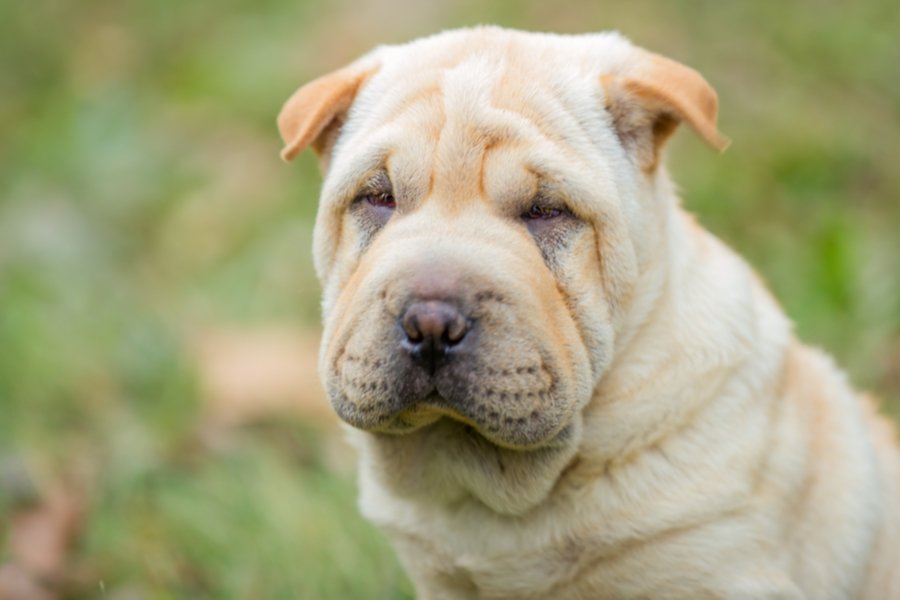
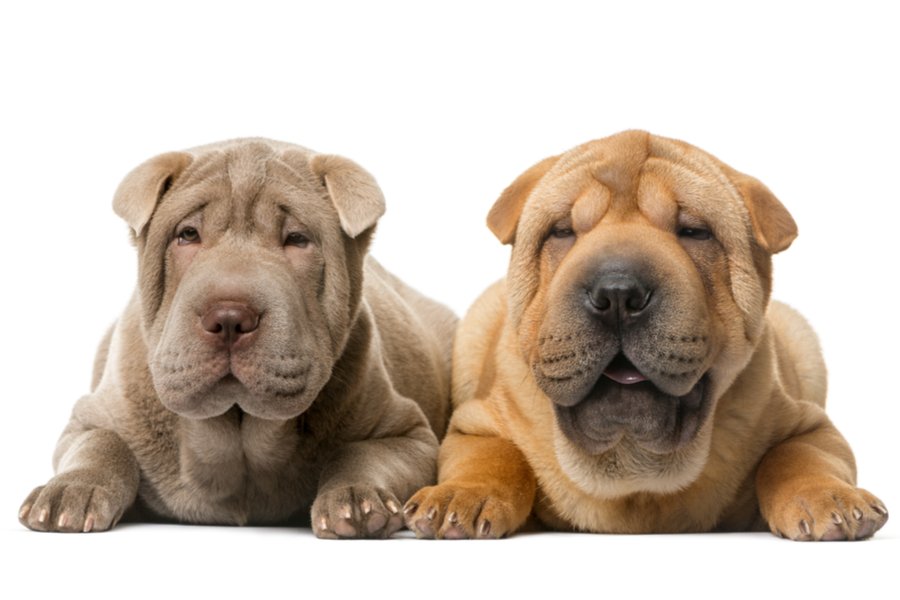
The average life expectancy of a Shar Pei is 8-12 years when correctly cared for. However, they are known to suffer from a few genetic health conditions. Make sure you only purchase your puppy from a trustworthy and licensed breeder. They will ensure your pup has been raised appropriately. They will also perform DNA tests to check for any underlying health conditions.
Some of the health issues seen in Shar Pei dogs include:
The Shar Pei is a devoted family dog who is protective of his family, including children. However, it’s essential that you expose the dog to children while they it is still young. Furthermore, you should teach your children how to appropriately approach and handle a dog. Remember that Shar Pei are large, muscular dogs. So, supervision is always recommended when around children of any age. They are best suited to homes with older children.
Due to their origin as fighting dogs, you will need to ensure that any other canine is introduced to your Shar Pei with care. If dogs are raised together, they usually have a much better chance of getting along.
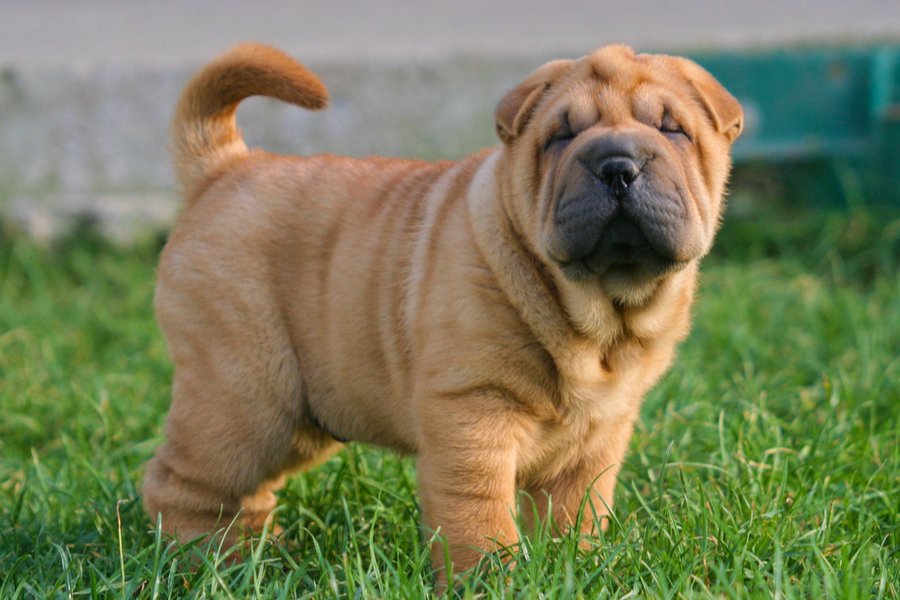
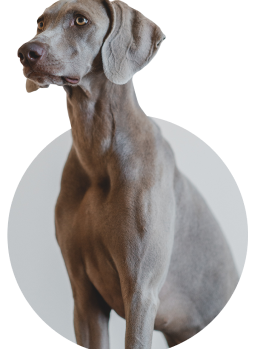
We can connect you with Breeders that are specialized in this particular breed.
See available puppies

Need some advice?
Whether you're a first time pet owner, an experienced pet owner, a new or long-time breeder, or just curious about pets, we've got you covered!
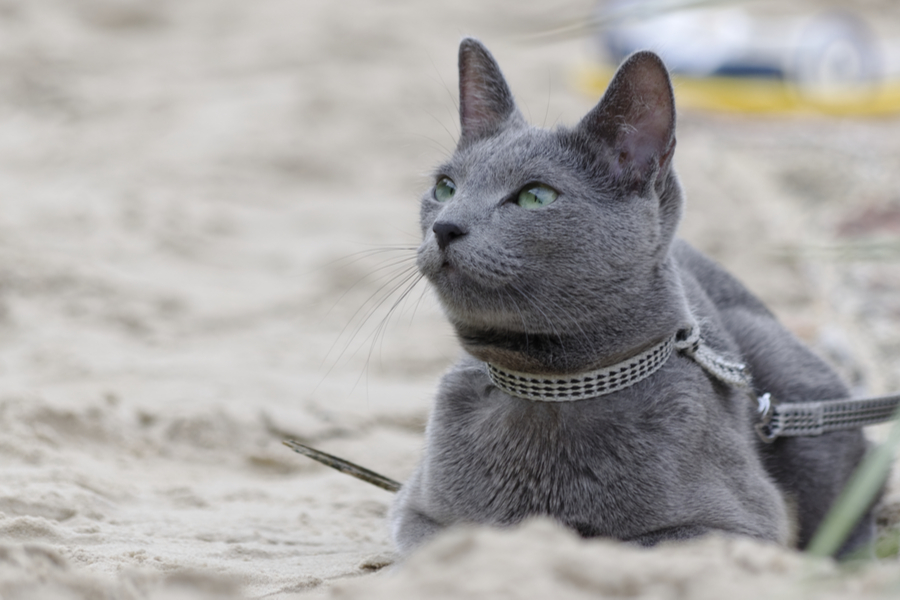
January 17, 2024
What Is The Personality Of Russian Blue Cats?
Russian Blue cats are most known for their distinctive shimmery blue-silver coat and piercing green eyes. However, this breed’s calm and gentle temperament is what makes them shine the most in the feline world.
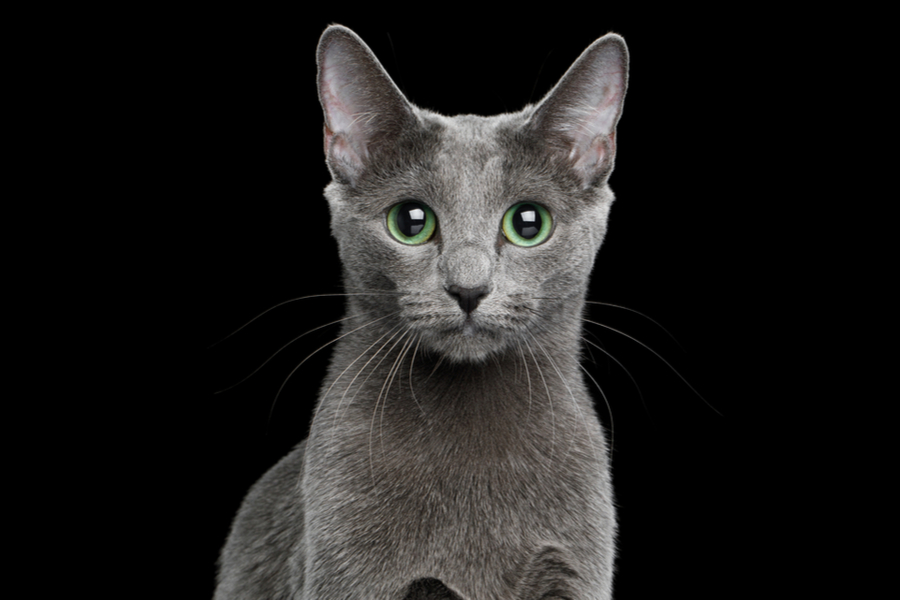
January 17, 2024
10 Facts About Russian Blue Cat Breed
Russian Blues are one of the most aesthetically stunning cat breeds, with a gorgeous plush silvery coat and vibrant green eyes. However, it’s not only their appearance that is beautiful; their nature is too.
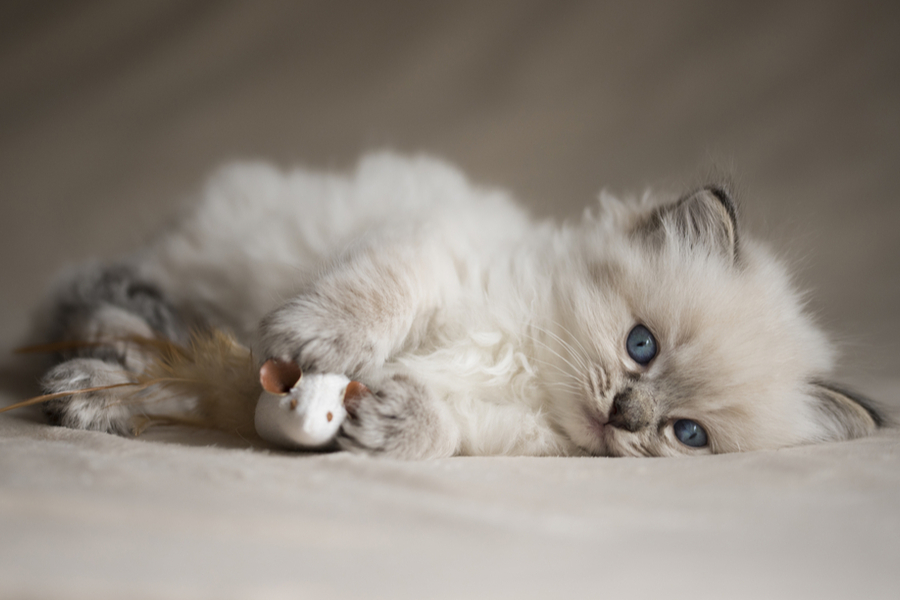
January 17, 2024
How To Choose The Right Cat Breed for You
Cats can make the most fantastic animal companions; they are adorable, friendly, and loving. However, not all felines are created equal. There are many different breeds, of which each has its unique personality traits.
Need some help?
Contact us to speak to our friendly advisor, who will gladly help you find your dream pet!



We are registered in England and Wales under registration number 12568840,
and our registered office is at 58-60 Kensington Church Street, W8 4DB London, England.
© 2023 The Pedigree Paws